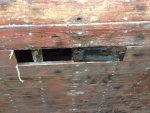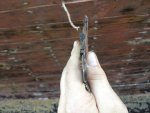JonnieFlamingo
New member
Afternoon m'learned colleagues, I have taken the plunge and removed a damaged plank from Flamingo (http://justflamingo.com/) My 8 year old is now even more convinced I am the proud owner of a shipwreck after I was forced to admit that, Yes, she would sink if we tried to sail her. The reason for the post is to get a bit of advice (obvs) the damaged plank was scarfed and because the planks are only 7/8ths thick the scarf was very thin, hence the damage. So my question is do I scarf a new bit in and glue it with a better adhesive (the original looked like grey putty), or cut the ends straight and reinforce with a butt plate?

Gulp! Now she'll definitely sink.

The very thin end of the wedge!
I await your pearls of wisdom... oh yes, and Happy New Year!
Jonnie

Gulp! Now she'll definitely sink.

The very thin end of the wedge!
I await your pearls of wisdom... oh yes, and Happy New Year!
Jonnie
